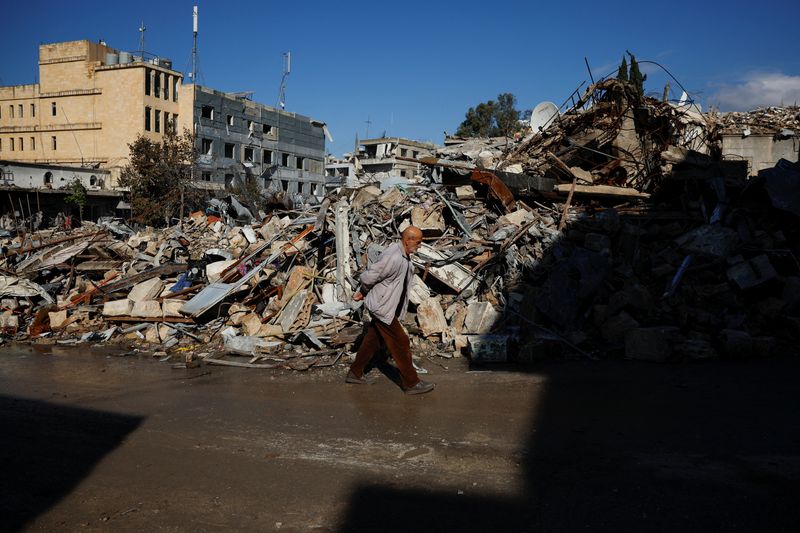By Maya Gebeily
BEIRUT (Reuters) -The Israeli military said its air force struck a facility used by Hezbollah to store mid-range rockets in southern Lebanon on Thursday, after both sides accused each other of breaching a ceasefire that aims to halt over a year of fighting.
Israel said it also opened fire on Thursday towards what it called “suspects” with vehicles arriving at several areas in the southern zone, saying it was a breach of the truce with Iran-backed armed group Hezbollah, which came into effect on Wednesday.
Hezbollah lawmaker Hassan Fadlallah in turn accused Israel of violating the deal.
“The Israeli enemy is attacking those returning to the border villages,” Fadlallah told reporters, adding “there are violations today by Israel, even in this form”.
The Lebanese army later accused Israel of violating the ceasefire several times on Wednesday and Thursday.
The exchange of accusations highlighted the fragility of the ceasefire, which was brokered by the United States and France to end the conflict, fought in parallel with the Gaza war. The truce lasts for 60 days in the hope of reaching a permanent cessation of hostilities.
Israel’s airstrike on Thursday was the first since the truce took effect on Wednesday morning. Lebanese security sources and the Al Jadeed broadcaster said it took place near Baysariyah, north of the Litani River.
The ceasefire deal stipulates that unauthorized military facilities south of the Litani River should be dismantled, but does not mention military facilities north of the river.
Earlier, Israeli tank fire hit five towns and some agricultural fields in southern Lebanon, state media and Lebanese security sources said, saying at least two people were wounded.
All of the areas lie within 2 km (1.2 miles) of the Blue Line demarcating the border between Lebanon and Israel, in an area the Israeli military has announced as a no-go zone along the border, even after the deal was agreed.
The Israeli military said in a statement it had identified several suspicious activities that posed a threat and breached conditions of the ceasefire agreement.
“Any deviation from this agreement will be enforced with fire,” said Chief of the General Staff Herzi Halevi.
Later on Thursday, Israeli Prime Minister Benjamin Netanyahu said he had directed the military to be prepared for intense fighting if the ceasefire is violated.
Lebanese families displaced from their homes near the southern border have tried to return to check on their properties. But Israeli troops remain stationed within Lebanese territory in towns along the border and Reuters reporters heard surveillance drones flying over parts of southern Lebanon.
The Israeli military on Thursday renewed a curfew restricting the movement of residents of southern Lebanon south of the Litani river between 5 p.m. (1500 GMT) and 7 a.m.
CEASEFIRE TERMS
The agreement, a rare diplomatic feat in a region racked by conflict, ended the deadliest confrontation between Israel and the Hezbollah militant group in years. But Israel is still fighting its other arch foe, the Palestinian militant group Hamas, in the Gaza Strip, in response to the deadly Hamas-led raid on southern Israel on Oct. 7, 2023.
Israeli strikes on Lebanon have killed at least 3,961 people and injured 16,520 others since October 2023, the Lebanese health ministry said on Thursday. The figures do not differentiate between civilians and combatants.
Hezbollah strikes have killed 45 civilians in northern Israel and the Israeli-occupied Golan Heights. At least 73 Israeli soldiers have been killed in northern Israel, the Golan Heights, and in combat in southern Lebanon, according to Israeli authorities.
Under the ceasefire terms, Israeli forces can take up to 60 days to withdraw from southern Lebanon but neither side can launch offensive operations.
Netanyahu waged the offensive against Hezbollah, saying Israelis in the north of the country should be able to return after being evacuated because of rocket fire from Lebanon.
Some 60,000 people evacuated from homes in the north have still not been directed to return.
Hezbollah has said its fighters “remain fully equipped to deal with the aspirations and assaults of the Israeli enemy” and that its forces will monitor Israel’s withdrawal from Lebanon “with their hands on the trigger”.
The group has been weakened by casualties and the killing of its leader Sayyed Hassan Nasrallah and other commanders by Israel.

Announcing the Lebanon accord on Tuesday, U.S. President Joe Biden said he would now renew his push for a ceasefire agreement in Gaza and urged Israel and Hamas to seize the moment. Months of efforts to negotiate a ceasefire have yielded scant progress.
Israeli military strikes killed at least 21 Palestinians across the Gaza Strip on Thursday, medics said, as forces stepped up their bombardment of central areas and tanks pushed deeper into the north and south of the enclave.



